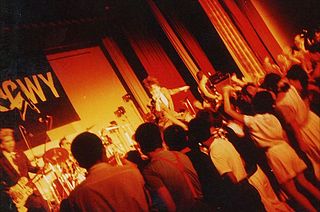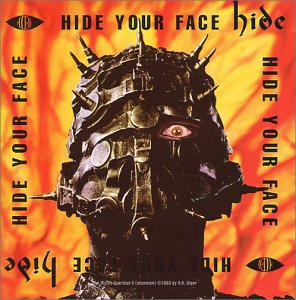
Paul Brandon Gilbert is an American hard rock and heavy metal guitarist. He is the co-founder of the band Mr. Big, and was also a member of Racer X, with whom he released several albums. In 1996, Gilbert launched a solo career, for which he has released numerous solo albums, and featured in numerous collaborations and guest appearances on other musicians' albums.

X Japan is a Japanese rock band from Chiba, formed in 1982 by drummer and pianist Yoshiki and lead vocalist Toshi. Starting as a predominantly power/speed metal band with heavy symphonic elements, they later gravitated towards a progressive sound with an emphasis on ballads. Besides being one of the first Japanese acts to achieve mainstream success while on an independent label, the group is widely credited as one of the pioneers of visual kei, a movement among Japanese musicians comparable to Western glam.

Hideto Takarai, known by his stage name Hyde, is a Japanese musician, singer-songwriter, record producer, and actor. Best known as the lead vocalist of the rock band L'Arc-en-Ciel since 1991, he is also the lead vocalist of Vamps and has a solo career.

Deacon Blue are a Scottish pop rock band formed in Glasgow during 1985. The line-up of the band consists of vocalists Ricky Ross and Lorraine McIntosh, keyboard player James Prime and drummer Dougie Vipond. The band released their debut album, Raintown, on 1 May 1987 in the United Kingdom and in the United States in February 1988. Their second album, When the World Knows Your Name (1989), topped the UK Albums Chart for two weeks, and included "Real Gone Kid" which became their first top ten single in the UK Singles Chart and reached number one in Spain. Deacon Blue released their fourth album, Whatever You Say, Say Nothing, in 1993.

Hideto Matsumoto, known professionally as hide, was a Japanese musician, singer, songwriter, and record producer. He achieved international fame as the lead guitarist of the rock band X Japan from 1987 to 1997 and a solo artist from 1993 onward. He also formed the United States-based rock supergroup Zilch in 1996.

Blaze Bayley is an English heavy metal singer. He was the lead singer of Wolfsbane from 1984 to 1994. He was also the lead singer of Iron Maiden from 1994 to 1999. Since then, he has pursued a solo career and has released eleven studio albums. Blaze was voted number 67 in Sweden Rock magazine's top 100 singers of all time.

Derek Sherinian is an American keyboardist of Armenian descent who has toured and recorded for Alice Cooper, Billy Idol, and Joe Bonamassa, among others. He was also a member of Dream Theater from 1994 to 1999, is the founder of Planet X and also one of the founding members of Black Country Communion, Sons of Apollo, and Whom Gods Destroy. He has released nine solo albums that have featured a variety of prominent guest musicians, including guitarists Slash, Yngwie Malmsteen, Allan Holdsworth, Steve Lukather, Joe Bonamassa, Michael Schenker, Steve Vai and Al Di Meola, and extensively drummer Simon Phillips.

Tomoaki Ishizuka, known exclusively by his stage name Pata, is a Japanese musician. He is best known as rhythm guitarist of the visual kei rock band X Japan. He joined the band in 1987, stayed with them until their dissolution in 1997, and rejoined when the band reunited in 2007.

Kyosuke Himuro is a former Japanese musician and singer-songwriter. He was the lead vocalist of the rock band Boøwy from 1981 to 1988. After the band disbanded, he went on to have a successful solo career, becoming one of Japan's best-selling artists. In 2003, HMV Japan ranked Himuro at number 76 on their list of the 100 most important Japanese pop acts. He currently lives in Los Angeles, California.

Boøwy was a Japanese rock band formed in Takasaki, Gunma in 1981. The classic lineup of vocalist Kyosuke Himuro, guitarist Tomoyasu Hotei, bassist Tsunematsu Matsui, and drummer Makoto Takahashi reached legendary status in Japan during the 1980s.

Blue Blood is the second studio album by Japanese rock band X Japan, then known as simply X. It was released on April 21, 1989, by CBS/Sony as the band's major label debut. Blue Blood sold more than 700,000 copies, reached number 6 on the Oricon chart and stayed on the chart for more than 100 weeks. The album's singles would also reach the top five on the chart. In 2007, Rolling Stone Japan ranked Blue Blood number 15 on their list of the "100 Greatest Japanese Rock Albums of All Time".

Vanishing Vision is the debut studio album by Japanese heavy metal band X Japan, then known as simply X. It was released on April 14, 1988 by Extasy Records, topped the Oricon indies chart and reached number 19 on the main chart.

Hide Your Face is the debut album by Japanese musician hide, released on February 23, 1994. It reached number 1 on the Oricon Albums Chart and was certified Double Platinum by the RIAJ for sales over 500,000 copies. It was named one of the top albums from 1989-1998 in a 2004 issue of the music magazine Band Yarouze.

Complete II is a box set released October 1, 2005. On ten CDs and nine DVDs it collects all studio and live albums, and all DVDs that X Japan released after changing their name from X, along with two DVDs containing previously unreleased and rare material from the band's earlier career. It reached number 92 on the Oricon chart.

Shibuya Public Hall is a theatre located in Shibuya, Tokyo, Japan. It was completed in 1964 to host the weightlifting events in the 1964 Summer Olympics.

X Visual Shock DVD Box is an X Japan box set released on July 23, 2008. It collects every home videos X Japan released before changing their name from X, along with one DVD containing previously unreleased material from the band's earlier career.

The Drums is an American indie pop band from New York City. The band was initially formed by Jonathan Pierce and Jacob Graham as Goat Explosion, and later added Adam Kessler and Connor Hanwick. Graham exited the band in 2016. Since then, the band has operated as a solo project of sole remaining member Jonathan Pierce.
Japanese metal is heavy metal music from Japan. The country's first metal bands formed in the mid-to-late 1970s. The number of acts increased significantly in the next decade, but only a few saw their material released internationally, including Europe and North America with their pre-established metal bases. Domestic metal saw its commercial peak in Japan in the late 1980s and early 1990s, with the top acts selling millions of records. Many metal bands from the visual kei scene toured and gained recognition in the West in the 2000s. The 2010s saw a boom of all-female metal bands form and gain mainstream attention.

















